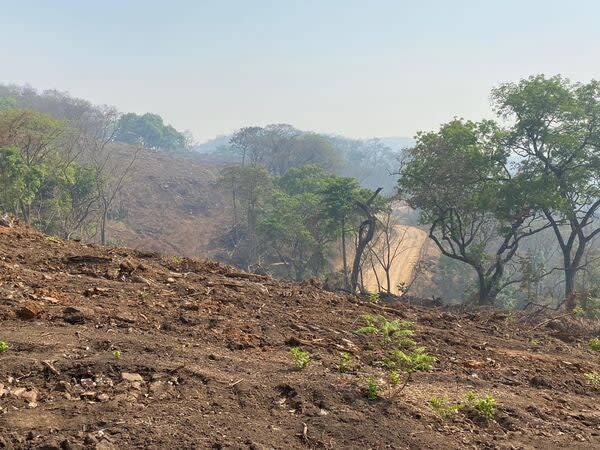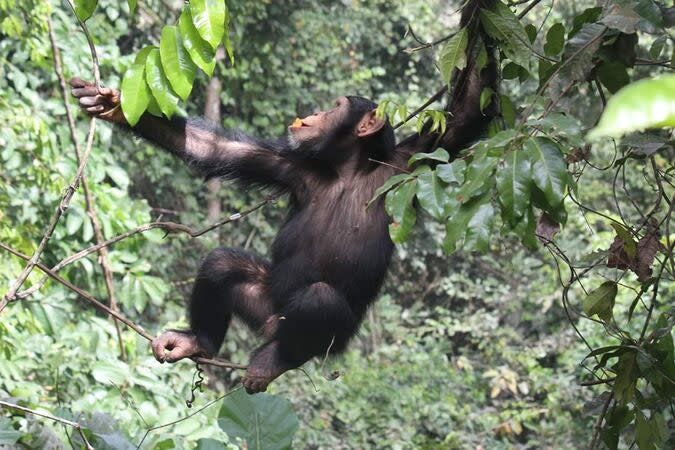The demand for rare earth elements in countries in Africa is driving the destruction of tropical rainforests, as it is home to over half of the world’s cobalt and copper. Now, the continent’s great ape population is more threatened from mining than scientists originally believed. A study published April 3 in the journal Science Advances estimates that nearly 180,000 gorillas, bonobos, and chimpanzees are at risk.
[Related: A deep sea mining zone in the remote Pacific is also a goldmine of unique species.]
“There has been an increase in mining in Africa to satisfy the demand from more industrialized countries and linked to the ‘green revolution’. This requires [a] significant amount of critical minerals to build electric cars, wind turbines, etc.,” Genevieve Campbell, a study co-author and primatologist with the International Union for Conservation of Nature (IUCN) and conservation nonprofit re:wild, tells PopSci. “Unfortunately the location of these minerals often overlap with ape habitat, but people are not aware of the impact of their consumption patterns on apes. This study aimed to quantify this impact and bring awareness to this issue.”
Looking at west Africa
In the study, an international team of scientists used data on operational and preoperational mining sites in 17 African countries and defined 6.2 mile wide buffer zones to account for direct impacts from mining, including habitat destruction and light and noise pollution. They also defined 31 mile buffer zones for the more indirect impacts linked to increased human activity near mining sites, including new roads and infrastructure to access formerly remote areas and more human presence. More human activity generally puts more pressure on the animals and their environments due to increased hunting, habitat loss, and a higher risk of disease transmission.
“Mining often exacerbates existing threats by, for example, building roads to remote areas that in turn facilitate access for hunters,” says Campbell.

Integrating the data on the population density of great apes allowed the team to pinpoint how many African great apes could be negatively impacted by mining activities and mapped out areas where high ape densities and heavy mining overlapped.
They found that more than one-third of the great ape population–180,000 animals–is in danger. The west African countries of Liberia, Sierra Leone, Mali, and Guinea had the largest overlaps of high ape density and mining areas. The most significant overlap of mining and chimpanzee density was found in Guinea, where more than than 23,000 chimpanzees (80 percent of the country’s ape population) could be directly or indirectly impacted by mining activities. The most sensitive areas are also not generally protected.
“I expected the spatial overlap between mining projects and ape habitat to be large and I suspected that previous estimates had underestimated the potential impact of mining-related activities on great apes,” study co-author and IUCN and re:wild conservation biologist Jessi Junker tells PopSci. “The results of this study thus didn’t really come as a surprise since no assessments at this spatial scale had been done previously.”
‘Critical Habitat’ zones
The study also explored how mining areas intersect with areas that could be considered ‘Critical Habitat.’ These regions have unique biodiversity and plant life that is crucial to a species’ survival. They found 20 percent overlap between proposed mining areas and Critical Habitat zones. When a region is designated this way strict environmental regulations can be implemented. These regulations particularly apply to any mining projects looking for funding from groups such as the International Finance Corporation (IFC) or other money lenders adhering to similar standards.


According to the team, previous efforts to map Critical Habitats in African countries have overlooked large portions of ape habitats that would qualify under international benchmarks.
“Companies operating in these areas should have adequate mitigation and compensation schemes in place to minimize their impact, which seems unlikely, given that most companies lack robust species baseline data that are required to inform these actions,” Tenekwetche Sop, a study co-author and manager of the great ape population database at the Senckenberg Museum of Natural History in Germany, said in a statement. “Encouraging these companies to share their invaluable ape survey data with our database serves as a pivotal step towards transparency in their operations. Only through such collaborative efforts can we comprehensively gauge the true extent of mining activities’ effects on great apes and their habitats.”
What can be done
In future research, the team hopes to quantify the direct and indirect impacts of mining activities in a different range of African countries and different ape species. Currently, these risks are not considered often and mitigated by mining companies. The study’s authors also urge mining companies to avoid their impacts on great apes and for more data collection to create a more accurate picture of where apes live in relation to where mining activities may take place.
[Related: How can we decarbonize copper and nickel mining?]
The general population also has a responsibility to ensure a shift away from fossil fuels does not come at the expense of biodiversity.
“We can all do something to help protect great apes and their habitat. It is crucial for everyone to adopt a mindset of reduced consumption,” says Junker. “Moreover, policymakers must enact more effective recycling policies to facilitate sustainable reuse of metals.”
